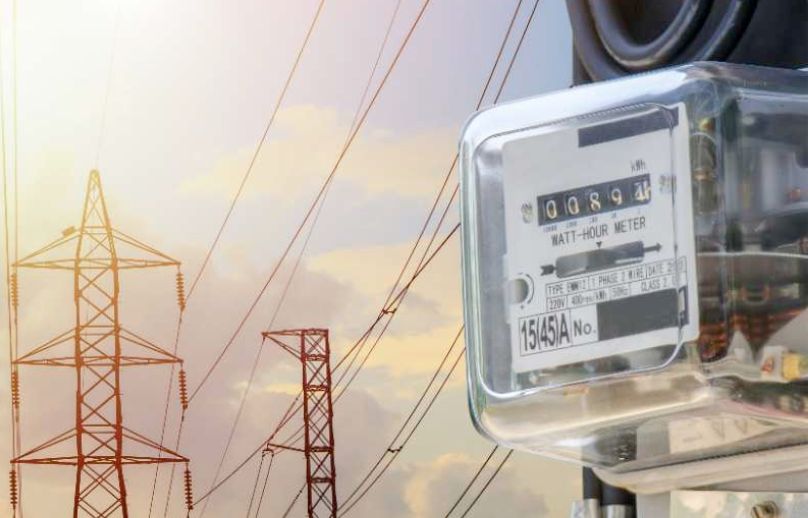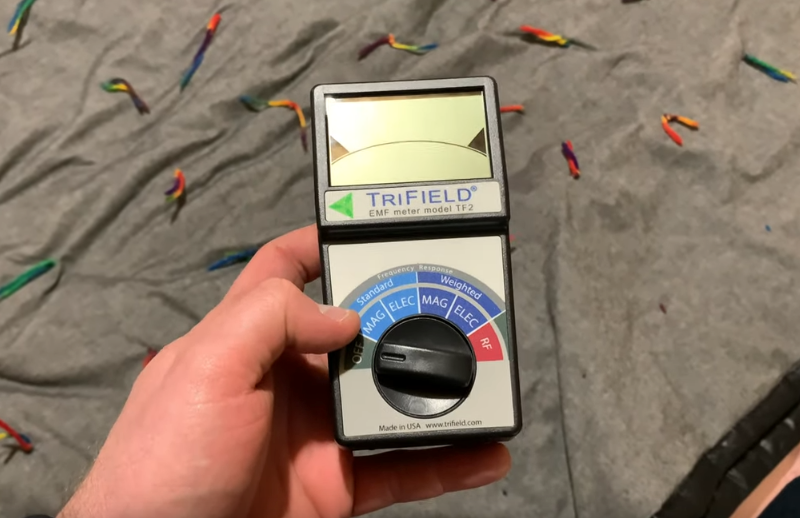Today’s homes are filled with electromagnetic fields (EMFs) from various sources. Understanding these fields and how to measure them can help you make informed decisions about your living environment. Explore the various EMF sources typically found in modern homes to get a broader perspective.
For a deeper understanding, you might want to review this comprehensive guide to the electromagnetic spectrum before we explore specific types.
Building Biology Recommended Levels
Building Biology practitioners have developed stricter guidelines based on observed biological effects, taking a more cautionary approach than standard regulations. Here are their recommended safety levels:
- RF radiation: Below 10 µW/m² is considered “no concern”
- AC magnetic fields: Below 0.2 milligauss (mG) is ideal
- Electric fields: Below 1.5 V/m for sleeping areas
These guidelines provide targets for creating optimal living environments. Keep these thresholds in mind as we explore each type of EMF in detail.
Recommended Meter for Home Testing
For home EMF assessments, I recommend the TriField TF2 meter. It’s an easy-to-use device that measures magnetic fields, electric fields, and RF radiation with a clear digital display and audio feedback. For more advanced measurement needs, see our detailed EMF Measurement Tools Guide at the end of this article.
1. Magnetic Fields: The Foundation of EMF Testing
Magnetic fields, measured in milligauss (mG), occur whenever electrical current flows through wires. Think of them as invisible force fields that radiate out from electrical sources.
While it’s normal to have some magnetic fields in your home, certain situations warrant closer attention. Learn more about household magnetic field sources here.
Watch out for these common magnetic field sources:
- When there are wiring mistakes in your home
- Old “knob-and-tube” wiring from the 1920s and 1930s
- Areas near overhead power lines
- Places where neutral wires are incorrectly connected in junction boxes
Key measurement principles:
- Take readings at different times of day
- Measure at various distances from potential sources
- Focus on areas where people spend extended time
- Keep detailed records of your findings
- Consider professional assessment for complex situations
2. Electric Fields: The Often Overlooked EMF
Electric fields exist whenever voltage is present in a wire, even if no current is flowing. Think of it like a garden hose connected to a faucet – there’s pressure in the hose even when the nozzle is closed.
Read this detailed overview of residential electric field sources and check out this essential guide to electric fields to better understand what generates electric fields around you.
Important characteristics:
- Present in any plugged-in cord, even when devices are off
- Can extend through walls
- Often strongest near ungrounded electrical devices
- May affect sleep quality
Measuring electric fields:
- Use a properly grounded meter
- Test at consistent heights and distances
- Consider multiple angles and positions
- Document readings systematically
Mitigation strategies:
- Unplug devices when not in use
- Consider installing demand switches for sleeping areas
- Use properly grounded outlets and devices
- Create distance between electrical sources and rest areas
3. Radio Frequencies: The Modern Challenge
In today’s wireless world, radio frequency (RF) fields come from numerous sources. Discover comprehensive strategies for RF protection and learn how to minimize exposure in your home. Check out this detailed guide to residential RF sources for a deeper understanding of where these fields originate.
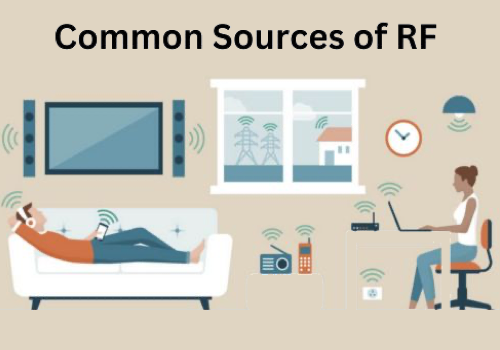
Common RF sources:
- WiFi routers and modems
- Cell phones and cell towers
- Smart meters for utilities
- Bluetooth devices
- Cordless phones
- Baby monitors
- Wireless security systems
- 5G networks
Important considerations for RF measurements:
- Signal strength typically decreases with distance
- Walls and floors can affect readings
- Measurements should be taken at least three feet from sources
- Consider cumulative exposure from multiple devices
- Test at different times of day
Reduction strategies:
- Turn off WiFi when not in use
- Keep wireless devices away from sleeping areas
- Use wired connections when possible
- Consider RF shielding options
- Opt for low-EMF alternatives when available
4. Dirty Electricity: Modern Technology’s Hidden Impact
Dirty electricity occurs when normal electrical current becomes disrupted or distorted. Learn everything you need to know about dirty electricity here. For a room-by-room analysis of common sources, explore this comprehensive guide.
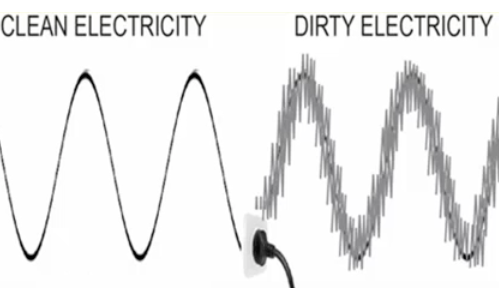
Common sources include:
- Electronic dimmer switches
- Compact fluorescent light bulbs
- LED lights (though newer models are improving)
- Variable speed motors
- Front-loading washing machines
- Energy-efficient furnaces
- Solar panel inverters
- Modern device chargers
- Switch-mode power supplies
Understanding Dirty Electricity:
- Can travel through home wiring
- May affect areas far from the source
- Varies based on device usage
- Can be measured with specialized meters
- May be reduced with appropriate filters
Testing Recommendations:
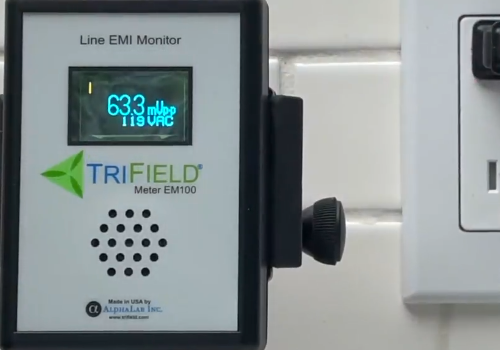
Before you begin testing, learn the proper methods for measuring dirty electricity. You’ll want to:
- Measure at multiple outlets
- Test before and after implementing solutions
- Monitor changes over time
- Consider professional assessment
- Document problem areas
For accurate measurements, you’ll need the right equipment. Review these top-rated dirty electricity meters to find the best option for your needs. Once you’ve identified issues, explore the most effective dirty electricity filters to address the problem.
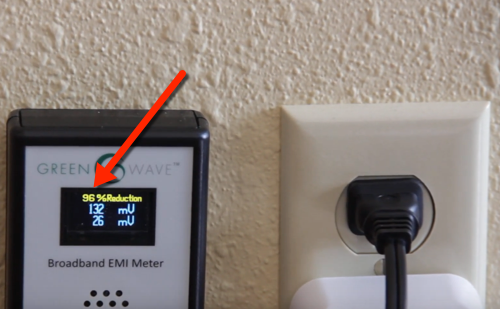
EMF Measurement Tools Guide
Choosing the right EMF meter is crucial for accurate assessment of your environment. Here’s a comprehensive guide to help you select the appropriate tool for your needs.
For Beginners: TriField TF2 Meter
- Measures: Magnetic fields, Electric fields, RF radiation
- Key Features:
- Simple, intuitive interface
- Digital display with backlight
- Sound feature for instant feedback
- Budget-friendly price point
- Click here to find the best price
- Best suited for: Initial home assessments and identifying EMF hotspots
Best Radio Frequency: Safe and Sound Pro II Meter
- Measures: Radio frequency (rf)
- Key Features:
- Professional-grade accuracy
- Clear numeric and audio feedback
- Peak hold function
- Excellent for RF detection
- Built-in sound signature analysis
- Click here to find the best price
- Best suited for: Regular home monitoring and detailed EMF surveys
For Professional EMF Assessment: Gigahertz Solutions ME3851A
- Measures: magnetic and electric fields
- Frequency range of 5 Hz to 100 kHz with built-in frequency filter options
- High precision measurements down to 0.1 V/m for electric fields and 0.001 mG for magnetic fields
- Key Features:
- Single-axis measurement for accurate source detection
- Built-in frequency filter for isolating different EMF sources
- Data logging capabilities through AC/DC outputs
- Audio feedback proportional to field strength
- Self-test mode for verifying accuracy
- Complete kit includes carrying case, grounding cable, and rechargeable battery
Using Your Meter Effectively:
- Always test at various heights and distances from potential sources
- Take multiple readings at different times of day
- Document your findings systematically
- Focus on areas where people spend the most time
- Consider consulting a professional for complex situations or high readings
Each EMF type section that follows will reference these meters with specific guidance for measuring that particular field type.
Creating a Healthier Home Environment
While completely eliminating EMFs isn’t practical in modern life, you can take steps to reduce exposure:
Immediate Actions:
- Turn off WiFi when not needed
- Keep electronics away from sleeping areas
- Use proper grounding for all devices
- Replace problematic switches or fixtures
- Choose EMF-conscious alternatives
- Unplug unused devices
- Create distance from sources
- Consider professional assessment
Long-term Strategies:
- Develop an EMF reduction plan
- Monitor levels regularly
- Update wiring when needed
- Choose low-EMF appliances
- Educate family members
- Stay informed about new solutions
Conclusion
Understanding and managing EMFs is an ongoing process. While we can’t eliminate all exposure in our modern world, informed choices and regular monitoring can help create a healthier living environment. Consider working with certified professionals for complex situations or if you’re particularly sensitive to EMFs.
Remember that EMF reduction is about balance – finding ways to enjoy modern technology while minimizing potential impacts on your living space. Regular assessment and adjustments to your EMF management strategy can help maintain this balance effectively.


